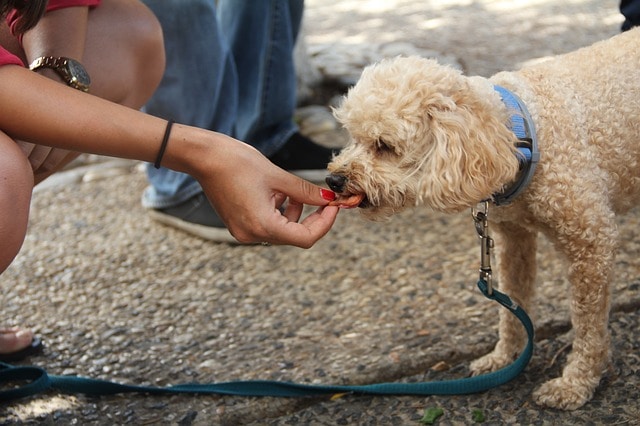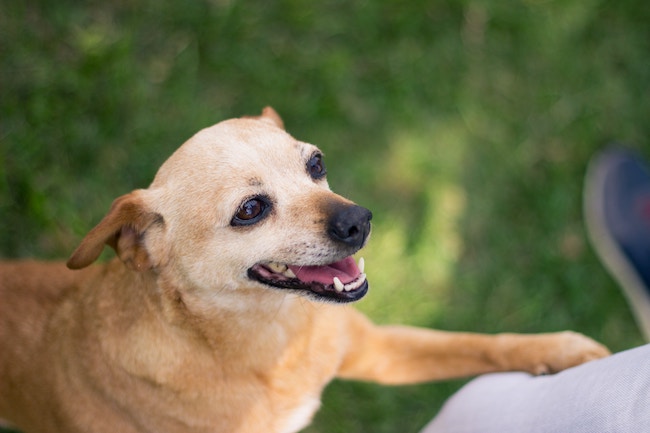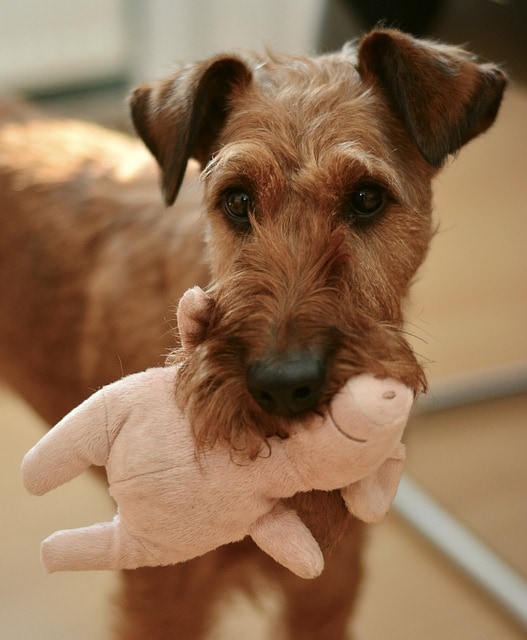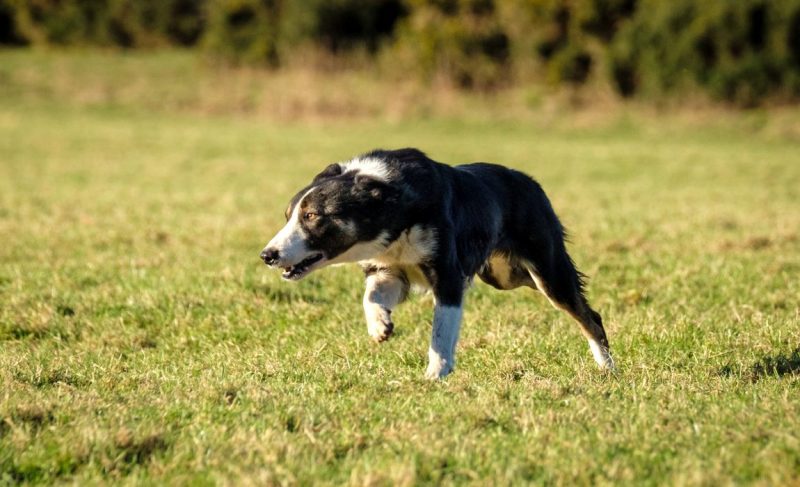Dogs bark – that’s why our ancestors liked having them around. Humans partially domesticated dogs because they’re amazing furry alarm systems
But in today’s bustling cities, a barky dog can be a nuisance to your neighbors. And for a dog who’s bred to keep guard and protect the house, the constant noises and passers-by of cities are incredibly stressful!
If your dog barks at everything, you’ve got a two-pronged problem on your hands: how to help your dog understand that he doesn’t need to be “on duty” all the time, and how to stop the barking so your neighbors don’t file a noise complaint.
Why Is My Dog Barking Non-Stop?
Whenever I’m looking at a problem behavior, I have two main questions:
- WTF? What’s The Function of this behavior? Why is your dog doing this? What reward does he get in exchange for the behavior? Why does he keep on doing it, over and over?
- What would we like your dog to do instead? Generally, we want to avoid phrasing the answer to this question as, “I want him to stop doing XYZ.” Pick a behavior that you want your dog to do instead of barking, and aim for something specific – such as lying on a bed, walking nicely beside you and offering eye contact, or grabbing a toy instead of barking.
In reality, your dog probably isn’t barking non-stop (though it can certainly feel like that). For extra-barky dogs, the SMART x 50 training method is incredibly helpful.
SMART x50: Teach Your Dog to “Do This, Not That”
This method requires that you give your dog 50 small treats or pieces of kibble per day when you catch your dog being good.
You can pick a few goal behaviors – like lying down or looking at you – or just pay more attention to your dog. Whenever you notice your dog is doing something that you like, take a moment to reward with some kibble.

I love this method because it teaches your dog to behave well without you telling him what to do. Even better, it helps you see the good in your dog’s behavior, rather than constantly trying to correct him.
This helps you shape your dog’s behavior very quickly into something easier to live with. It’s amazing how quickly your dog’s barking will reduce when you simply reward him 50 times per day for not barking!
For Dogs That Bark at Things
For the most part, dogs bark at things because they’re either scared of something or because they want the thing to leave “My Turf” – or both. This answers the WTF question!
The function of your dog’s barking is to make things go away either because they’re scary or because they’re intruders.

Now that we understand that your dog is probably barking because he wants something or someone to leave, we know that we can change his emotional response to the thing. That, in turn, should reduce the barking.
Once your dog realizes that leaves rustling in the wind, baby strollers going by outside, neighbors, and other dogs all make chicken appear in your hands, he’ll start feeling better about them. This will make him less likely to “yell at them” in the future.
To fix this problem, all you have to do is get some treats and start paying attention. As soon as your dog’s barking trigger appears, drop some food to your dog – every time, even if your dog is already barking!
This is called classical conditioning. Remember Pavlov’s dogs and the bell that made them drool? Our goal is to make neighbors, strange dogs, baby strollers, and strange noises into Pavlov’s Bell.
When your dog hears something that he used to bark at, he should now think, “Oh boy! CHICKEN!”

This requires consistency on your part. Classical conditioning works best when the trigger always produces the food, and when the time between the trigger appearing and the food appearing is short.
In other words, you can’t withhold food when your dog is barking and expect this to go quickly. Nor can you give your dog food five minutes after the trigger left and expect him to make the connection.
If your dog is so worked up about the trigger that he can’t or won’t eat, you’re too close. You can still offer food, but it’s like offering someone an ice cream cone in the climax of a horror movie – now is not the time. He’s just too upset to eat right now! Back up or make the trigger more quiet and try again.
For dogs who bark at visual triggers (like people, cars, or other dogs), set up training scenarios where your dog is at a safe distance from the trigger. Try waiting at the far side of a parking lot, across the field from a dog park, or near a vet’s office.
We have a great video below that shows how an owner can use counter-conditioning to work on a dog’s nuisance barking issues:
A good training setup is one where you can reliably predict where your dog’s triggers will be.
If your dog barks out the window all day, get some window film and a white noise generator so he doesn’t keep practicing this unwanted behavior!
For dogs with noise phobias, I really like to use the Train Away App – see the video below.
For Dogs That Bark When Left Alone
Some dogs that bark while left alone have separation anxiety. This behavioral problem is actually more like a panic disorder in many ways.
That said, not all dogs who bark while they’re alone have separation anxiety. Your barker could be bored or responding to sounds and movements outside.
If your dog barks while he’s left home alone, use a camera to check in on his body language. Is he pacing, drooling, and generally stressed-looking? Then you might be dealing with a case of separation anxiety.
But if he’s barking at the window, the door, or passers-by, it’s probably more about his environment than about anxiety.
The best way to know for sure is to video your dog while you’re gone. I personally use a Furbo, which has helped me check in on Barley during the day, feed him treats intermittently, and get notified if he barks. Once you get the barking notification to your phone, you can see what your dog is up to.
Dog cameras with treat-dispensing features are great for monitoring your pooch as well as working on training, even when you’re out of the house. Furbo is the most popular, but there are several treat-throwing dog cameras on the market you can check out.
Here’s a peek at how Furbo works from The Verge:
Finally, a dog who is barking from boredom is more likely to produce repeated, short barks, rather than the frantic-sounding whines, howls, yips, and barks characteristic of separation anxiety. Read more about different dog barks here.
If you’re not sure what you’re seeing on video, get help from a professional (my partner at Journey Dog Training is a separation anxiety specialist who runs regular online classes).
Dogs with separation anxiety need a systematized plan for desensitization to being alone (we have a desensitization plan you can download below).
This process can be tedious, but it has a high rate of success.
Dogs who bark from boredom should be given more to do! We have a whole list of ways to keep your dog from getting bored. If you do nothing else, I strongly recommend throwing out your dog’s food bowl and replacing it with hidden puzzle feeders while you’re away.
If your dog is barking at sounds or passers-by while you’re away, you’ll need to use the same tactics outlined above for dogs that bark at things. Many of these suggestions apply for dogs that bark at night as well, although improper crate training can also play a role for all-night yappers.

For Dogs That Bark at Their Owners
Ok, so what if you’re the target of your dog’s woofs? WTF? What’s the function of that behavior? Most likely, it’s because your dog wants something from you – and you’re likely to give in when she barks.
Think hard – what do you do after your dog barks at you? Do you scold him (that’s attention, which he might like)? Do you let him outside? Do you pet him to calm him down?

Once you realize what it is that your dog is barking for, now it’s time to teach your dog that he can get the same consequence without barking.
- Find the situations where your dog is likely to bark, and figure out how you are inadvertently rewarding your dog for barking.
- Now change the setup: rearrange your habits so that when you put your dog in a situation where he might bark at you, you’re ready to reward him with what he wants (attention, pets, a potty break, a game) before he barks.
- If your dog does bark at you, turn and leave the room for 5-10 seconds. When you come back from the time out, come armed with something new – toys or treats are best. Then engage your dog with the new object so that you don’t get stuck in a bark-time-out-bark loop.
Demand barking can be a huge pain to live with, but it’s actually surprisingly easy to change because YOU are doing something that keeps your dog’s barking going. If you change your response to your dog’s barks and teach him that quiet behavior gets him his rewards, you’ll fix the problem.
For Dogs That Bark at Guests
Many dogs lose their minds when someone comes to the door – this is pretty common.
It can be pretty embarrassing to live with a dog that barks at people constantly and harasses your visitors, so it’s definitely worthwhile to work on polite greetings and teaching your dog to not jump up on guests.
Method 1: Greet Guest With a Toy
One of my favorite tactics for dogs that bark at guests is to teach the dog to go grab a toy, then greet the guests with the toy in their mouths. This works best if your dog already knows how to grab a toy on cue, and if your dog loves toys.
To practice, simply knock softly on the wall or table, then tell your dog to grab his toy. When he does, play briefly. Repeat over and over as you knock more unexpectedly and more loudly. You can even start calling, “Who is it?” to your fake guest as you practice.

Method 2: Guests Mean Treats
If your dog isn’t very toy-motivated, you can do a similar protocol where you knock on the door, then toss treats to your dog.
This doesn’t really reach your dog what to do when the doorbell rings, but it does teach your dog to come running and look for treats when a visitor arrives at the front step!
If your dog barks at guests once they’re inside, you’ve got a bit more of a project ahead. This is usually a sign of nervousness in your dog (not dominance, or a little dog who thinks he’s a big dog). Have your guests toss treats to your dog and move slowly. Remove your dogs from the situation if you don’t want to be in “Dog Trainer Mode” .
Can I Stop My Dog’s Barking With a Dog Bark Collar?
If you’ve made it this far in this post, you might be surprised that I haven’t yet mentioned bark collars for dogs. There are several big reasons that I do not recommend using a bark collar to stop your dog’s barking:
- Bark collars don’t address why your dog barks. Remember how I said I always want to know WTF (What’s The Function)? That’s because it’s important to meet your dog’s needs as you treat a behavior problem. If your dog barks because he’s scared and then you start punishing him for barking, you’re really not helping your dog!
- Bark collars don’t tell your dog what to do instead. I’ve personally seen several instances where dogs become frantic when they hear the warning tone of an e-collar. That’s because they’re not clear on what to do to avoid the shock. Even in less extreme cases, it’s very hard to use an e-collar to show your dog that being quiet is the goal behavior.
- Bark collars raise stress for dogs, rather than reducing it. Most dogs bark from stress. Bark collars work because they’re upsetting to the dog (see #5). If you screamed from fear at a horror movie and were shocked for it, that might reduce your screaming. But you’d also be more upset than you were previously. This, along with #2, probably explains why some dogs who wear bark collars turn to destroying the house, urinating indoors, or even biting their owners.
- Bark collars were reported to only be 25% effective in a study of 1251 owners. A 2017 study in France found that only 1 in 4 owners who used a bark collar found the collar was effective. So the collar may be causing stress for your dog, yet your dog is still barking! The same study found that bark collars are also most likely to cause injury to dogs, with 10.7% of the dogs with bark collars suffering from burns, hair loss, or other injury. This is probably because bark collars, unlike other e-collars, are likely to be used many times per day without the input of an owner or trainer.
- Vibration, citronella, ultrasonic, and shock collars all work only if dogs find them aversive. I strive to avoid pain, stress, and fear in my training at all times. Bark collars work by startling, hurting, or scaring your dog in order to teach them that “barking is wrong.” If they weren’t upsetting to the dogs, they wouldn’t work!
But aside from my ethical issues with correction-based training, there’s the fact that bark collars don’t even work very well. Citronella-based collars, vibration collars, and shock collars all work to punish your dog for barking – and I don’t approve of any of them!
There’s no such thing as a humane bark collar – they all work by causing discomfort or pain to your dog.
How to Stop Nuisance Barking: Dog Bark Collar Alternatives
I’ve already outlined the fixes for some of the main reasons that your dog might bark at everything. But if you’re still stuck, try to think like a dog trainer.
Remember: what is the function of your dog’s barking (what happens after she barks that might be the reason she keeps barking) and what would you like her to do instead?
Most trainers work through problem behaviors using a format called the Humane Hierarchy. You can use this format to stop your dog from barking without a bark collar.
The key with the Humane Hierarchy is to work through each level thoroughly before progressing to the next. You can’t give a cursory nod to physical health and move right on to training and expect great results!
- Address Your Dog’s Physical and Mental Wellbeing. Is he bored all day? Is he pain-free? Are you sure? A full vet checkup can reveal surprising reasons for many behavior problems, and effectively reducing boredom (and increasing exercise with activity walks) can do wonders for many behavior problems!
- Set Up the Environment for Success. If your dog barks at other dogs, avoid the dog park on your walks. If your dog barks at stuff out the window, get some window film! You wouldn’t expect your eight-year-old to learn at Chuck-E-Cheese’s, so don’t expect your dog to do the equivalent.
- Use Positive Reinforcement to Show Your Dog How to Behave. This is where the SMART x 50 training approach is huge. You can also give treats whenever your dog’s trigger appears.
- Reward Your Dog for Not Barking in Tempting Situations. This comes after #3 because it requires putting your dog in tempting situations. Make sure that your dog is already very successful with #3 first.
- Ignore Barking and Withhold Good Stuff When Your Dog Barks. This is a great approach for so-called demand barking. But it also shouldn’t be your first step: you’ve got to make sure that the other four steps are addressed before you start to ignore your dog! Otherwise, you’re just increasing frustration.
- Punish the Dog for an Unwanted Behavior. This is not a step that I have ever found necessary for a barking dog. With skillful application of the first five steps of the Humane Hierarchy, you should be just fine. Remember, bark collars aren’t even that effective and may harm your dog. If you find yourself browsing Amazon for bark collars, ask yourself whether you’ve really addressed #1 – #5 as well as you possibly can!
When you’re really stuck with a problem behavior, don’t reach for the heaviest tool available (in the case of barking, that’s a bark collar or de-barking). Why use a chainsaw to remove a door from its hinges when a screwdriver would do?
Have you ever had to deal with a nuisance barker? How did you end up resolving your dog’s constant barking? Share your experience in the comments!








Leave a Comment